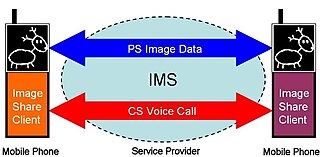Bluetooth is a short-range wireless technology standard that is used for exchanging data between fixed and mobile devices over short distances and building personal area networks (PANs). In the most widely used mode, transmission power is limited to 2.5 milliwatts, giving it a very short range of up to 10 metres (33 ft). It employs UHF radio waves in the ISM bands, from 2.402 GHz to 2.48 GHz. It is mainly used as an alternative to wire connections, to exchange files between nearby portable devices and connect cell phones and music players with wireless headphones.
An Internet Protocol address is a numerical label such as 192.0.2.1 that is connected to a computer network that uses the Internet Protocol for communication. An IP address serves two main functions: network interface identification and location addressing.
The Internet protocol suite, commonly known as TCP/IP, is a framework for organizing the set of communication protocols used in the Internet and similar computer networks according to functional criteria. The foundational protocols in the suite are the Transmission Control Protocol (TCP), the User Datagram Protocol (UDP), and the Internet Protocol (IP). Early versions of this networking model were known as the Department of Defense (DoD) model because the research and development were funded by the United States Department of Defense through DARPA.
The Session Initiation Protocol (SIP) is a signaling protocol used for initiating, maintaining, and terminating communication sessions that include voice, video and messaging applications. SIP is used in Internet telephony, in private IP telephone systems, as well as mobile phone calling over LTE (VoLTE).
The data link layer, or layer 2, is the second layer of the seven-layer OSI model of computer networking. This layer is the protocol layer that transfers data between nodes on a network segment across the physical layer. The data link layer provides the functional and procedural means to transfer data between network entities and may also provide the means to detect and possibly correct errors that can occur in the physical layer.
SIMPLE, the Session Initiation Protocol for Instant Messaging and Presence Leveraging Extensions, is an instant messaging (IM) and presence protocol suite based on Session Initiation Protocol (SIP) managed by the Internet Engineering Task Force.

The list price, also known as the manufacturer's suggested retail price (MSRP), or the recommended retail price (RRP), or the suggested retail price (SRP) of a product is the price at which its manufacturer notionally recommends that a retailer sell the product.
Gizmo5 was a voice over IP communications network and a proprietary freeware soft phone for that network. On November 12, 2009, Google announced that it had acquired Gizmo5. On March 4, 2011, Google announced that the service would be discontinued as of April 3, 2011.
Sitemaps is a protocol in XML format meant for a webmaster to inform search engines about URLs on a website that are available for web crawling. It allows webmasters to include additional information about each URL: when it was last updated, how often it changes, and how important it is in relation to other URLs of the site. This allows search engines to crawl the site more efficiently and to find URLs that may be isolated from the rest of the site's content. The Sitemaps protocol is a URL inclusion protocol and complements robots.txt, a URL exclusion protocol.
Multiple Registration Protocol (MRP), which replaced Generic Attribute Registration Protocol (GARP), is a generic registration framework defined by the IEEE 802.1ak amendment to the IEEE 802.1Q standard. MRP allows bridges, switches or other similar devices to register and de-register attribute values, such as VLAN identifiers and multicast group membership across a large local area network. MRP operates at the data link layer.
Stream Reservation Protocol (SRP) is an enhancement to Ethernet that implements admission control. In September 2010 SRP was standardized as IEEE 802.1Qat which has subsequently been incorporated into IEEE 802.1Q-2011. SRP defines the concept of streams at layer 2 of the OSI model. Also provided is a mechanism for end-to-end management of the streams' resources, to guarantee quality of service (QoS).

Image Share is a service for sharing images between users during a mobile phone call. It has been specified for use in a 3GPP-compliant cellular network by the GSM Association in the PRD IR.79 Image Share Interoperability Specification.
VMware Horizon is a commercial desktop and app virtualization product developed by VMware, Inc for Microsoft Windows, Linux and macOS operating systems. It was first sold under the name VMware VDM, but with the release of version 3.0.0 in 2008 it was changed to "VMware View". The name was updated to "Horizon View" with the launch of version 6 in April 2014 and is now referred to as "VMware Horizon" to represent desktop and app virtualization.
In computer networking, the Message Session Relay Protocol (MSRP) is a protocol for transmitting a series of related instant messages in the context of a communications session. An application instantiates the session with the Session Description Protocol (SDP) over Session Initiation Protocol (SIP) or other rendezvous methods.

Blink is a Session Initiation Protocol (SIP) client distributed under the Blink license.
Time-Sensitive Networking (TSN) is a set of standards under development by the Time-Sensitive Networking task group of the IEEE 802.1 working group. The TSN task group was formed in November 2012 by renaming the existing Audio Video Bridging Task Group and continuing its work. The name changed as a result of the extension of the working area of the standardization group. The standards define mechanisms for the time-sensitive transmission of data over deterministic Ethernet networks.

The Forte VFX1 Headgear was a consumer-level virtual reality headset marketed during the mid-1990s. It comprises a helmet, a handheld controller, and an ISA interface board, and offers head tracking, stereoscopic 3D, and stereo audio.
The Pixel 3a and Pixel 3a XL are a pair of Android smartphones designed, developed, and marketed by Google as part of the Google Pixel product line. They collectively serve as mid-range variants of the Pixel 3 and Pixel 3 XL. They were officially announced on May 7, 2019 at Google I/O, seven months after the announcement of the original Pixel 3 lineup, and were released on the same day. On August 3, 2020, it was succeeded by the Pixel 4a.
Raptor Lake is Intel's codename for the 13th-generation of Intel Core processors based on a hybrid architecture, utilizing Raptor Cove performance cores and Gracemont efficient cores. Raptor Lake launched on October 20, 2022. Mobile versions are expected to be released by the end of the year. Like Alder Lake, Raptor Lake is fabricated using Intel's Intel 7 process. At Intel's Investor Meeting 2022, it was confirmed that Raptor Lake would feature up to 24 cores and 32 threads and is socket compatible with Alder Lake systems.



